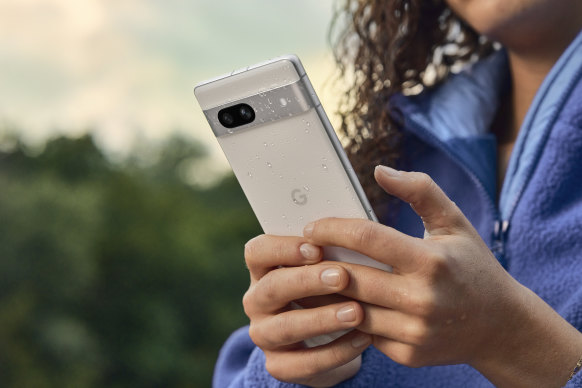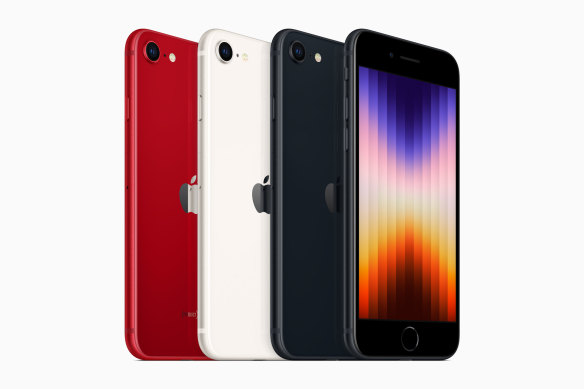- Analysis
- Technology
- Phones
Google’s Pixel 7a shows why we should demand more from Apple’s iPhone SE
By Tim Biggs
Google’s latest smartphone in its Pixel A series, once again, is phenomenal value. It offers an experience mostly on par with the most expensive Android handsets, and all for $750. In fact, the Pixel 7a sets such a high standard for a device at the top end of the sub-$1000 market, it shows that we should justifiably expect more from Apple’s own lower-cost efforts.
Comparing the Pixel 7a and the similarly priced iPhone SE, it’s not even close; the 7a is superior in almost every measure. But this isn’t the most useful comparison, since most people are locked into either the Apple or Android ecosystem and aren’t considering a cut-price Pixel as an upgrade to their old iPhone.

The Pixel 7a is a less expensive version of last year’s Pixel 7.
The important takeaway here is that Google offers a smartphone with the essence of a top-of-the-line experience, and the overwhelming bulk of its newest features, and applies them to a less-expensive phone, while Apple does not.
The 7a has a 6.1-inch OLED screen with the same HD+ resolution as the standard Pixel 7, HDR10+ compatibility and a smooth 90Hz refresh rate (which stays at 90Hz almost all the time, unlike most inexpensive phones with high refresh rates). It looks almost exactly like the Pixel 7, and I was surprised to learn it was metal and plastic rather than metal and glass, given it feels so glossy and still supports wireless charging.
It’s powered by the same Tensor processor as the Pixel 7 and packs three new cameras (a wide and ultrawide on the rear, plus the selfie cam) which can all do long exposure or night photography shots, and film in 60 frames per second or 4K. All of Google’s latest AI photo tricks are included as well, like super resolution zoom (which works best at 2x or 3x), face unblur and magic eraser.
Across the board the software experience is also exactly what you’d expect from a new Google phone – clean and simple with a focus on AI-powered tasks, and flexibility to add the apps and features you want rather than starting off with a phone full of bloat.
What the Pixel 7a truly feels like is the default Android smartphone you could recommend to anybody. It doesn’t go the extra mile with niche features like a $1500 phone does, but it also doesn’t make any compromises, and showcases the operating system and Google services at their very best.
On the other hand, if we compare Apple’s iPhone SE to the iPhone 14, we unavoidably come away with the impression that the former is a limited (and limiting) alternative.
The SE is only a centimetre or so shorter than the 14, but the screen is smaller (61 millimetres versus 90 millimetres) owing to the massive old-fashioned bezels and Home button. It’s a comparatively dull LCD panel with no HDR and a sub-HD resolution, which was great on the 2014 iPhone 6 but doesn’t really suit the latest iOS and apps.
Camera-wise things aren’t much better, with the 2016-era single shooter taking nice enough shots thanks to the modern processing and software in the SE. But you won’t be getting up close, zooming very far or taking photos in low light.

The third generation iPhone SE was introduced last year.
The battery on the SE is a tiny 2018 mAh compared to the iPhone 14’s 3279 mAh, which in real usage does mean it doesn’t last as long. However, its tiny screen means it uses a lot less power, so the SE does generally last all day.
The SE does use a processor that’s very similar to the iPhone 14, meaning performance is quick and compatibility with apps and services is excellent. In years past, this parity would be a point of difference in favour of Apple’s budget phone, but these days, Google does this as well. And despite the horsepower (Apple’s A15 is plainly more powerful than Google’s Tensor G2), the SE still lacks some features that all other current iPhones have, like Atmos sound, an ultra-wideband chip for finding things, Memoji, night photography and audio zoom.
iPhones, of course, are more expensive in general than Pixels; the Pixel 7 is $1000, while the iPhone 14 is $1400. So you could argue that the iPhone 12 or 13, which Apple still sells at $1130 and $1230, is the company’s equivalent of the Pixel 7a.
Indeed, you could even make an argument that Google selling the 7a for a bit less than the 7 is like Apple discounting the price of last year’s iPhone when it introduces a new one; Google’s just doing it a few months before the Pixel 8 arrives, and has tweaked the older phone to cut costs. But no matter how you justify it, there’s no getting around the fact that Apple’s older phones look overpriced, and its SE looks ridiculous, in the wider context of smartphones in 2023.
Originally, the iPhone SE seemed like a concession to older users who didn’t like the new full-screen design of the iPhone X, but needed newer hardware to make use of Apple’s newest software and services. But today it seems a bit like an insult; if you want a new iPhone below $1000 you can either get a 2019 iPhone 11 from a retailer, or settle for the retro SE.
Today, Pixel users can pay $750 for a new device that’s more or less last year’s flagship Google phone. That doesn’t feel like a compromise. If Apple decides to make a fourth generation iPhone SE it could stand to follow suit, with a screen, cameras and features that not only look like they belong in the 2020s, but can become a default for users with moderate smartphone needs.
Get news and reviews on technology, gadgets and gaming in our Technology newsletter every Friday. Sign up here.